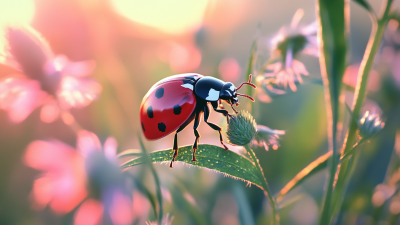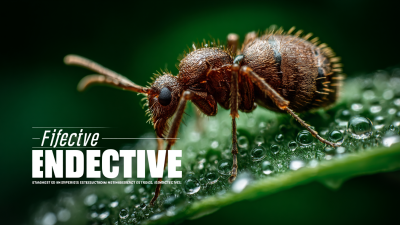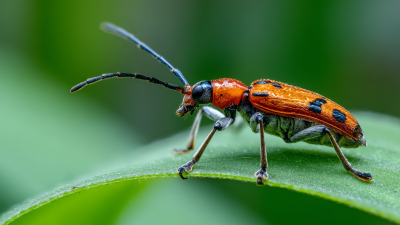 0551-68500918
0551-68500918 





 As the world of agriculture keeps changing, the Insecticide Market is pretty much on the brink of some major shifts. It’s being driven by new trends, cutting-edge tech, and a real push toward moreeco-friendly solutions. Companies like Innovation Meiland (Hefei) Co., LTD are really leading the way here—they’re all about researching and developing new pesticides, formulations, and methods that fit modern farming practices. With more and more farmers looking for effective pest control, and everyone becoming more aware of how these chemicals affect the environment, there’s definitely a move toward more sustainable insecticide options. In this look at what’s ahead for the insecticide market, we’ll explore the latest trends and innovations shaping the industry, especially highlighting how organizations like Meiland are pushing forward with solutions that meet the needs of both farmers and consumers—while also keeping our ecosystems in mind.
As the world of agriculture keeps changing, the Insecticide Market is pretty much on the brink of some major shifts. It’s being driven by new trends, cutting-edge tech, and a real push toward moreeco-friendly solutions. Companies like Innovation Meiland (Hefei) Co., LTD are really leading the way here—they’re all about researching and developing new pesticides, formulations, and methods that fit modern farming practices. With more and more farmers looking for effective pest control, and everyone becoming more aware of how these chemicals affect the environment, there’s definitely a move toward more sustainable insecticide options. In this look at what’s ahead for the insecticide market, we’ll explore the latest trends and innovations shaping the industry, especially highlighting how organizations like Meiland are pushing forward with solutions that meet the needs of both farmers and consumers—while also keeping our ecosystems in mind.
The global household insecticide market is really looking at some solid growth ahead. Experts are saying it could hit around $29.5 billion by 2033, growing at about 7.8% each year. That's pretty telling—people are definitely more interested in effective pest control solutions these days, especially with all the worries about health and safety in our homes. With cities expanding and lifestyles changing, we're seeing more pests becoming a real headache, so manufacturers are pouring effort into creating smarter, more sustainable products that actually meet our needs.
Lately, there’s been a noticeable shift toward eco-friendly insecticides and alternative methods for keeping those unwanted bugs at bay. People are more aware than ever about how chemicals can impact the environment and what's left behind in our homes. Plus, in places like New Zealand, there's a real lack of detailed info about pesticide use, especially with things like neonicotinoids. That highlights just how much we still need to understand about these products and their effects. Having better data is key—not just for making smarter regulations but also for developing solutions that are safe for us and better for the planet. All in all, it’s an exciting time for the insecticide market as it evolves to meet these new challenges and priorities.
This bar chart illustrates the growth of the Global Insecticide market from 2020 to 2023, highlighting a steady increase in sales. This trend reflects ongoing innovations and shifts toward more sustainable solutions in pest management.
You know, cutting-edge tech is really turning things around in how we develop insecticides. It's all part of this bigger shift towards more sustainable farming practices. For example, folks are now adding biostimulantsinto the mix, which helps crops get stronger naturally, all while cutting down on Chemical Pesticides. It’s pretty cool because not only does this boost plant health, but it also helps the environment—less runoff, more biodiversity, you know? On top of that, with the rise of precision agriculture—thanks to AI and remote sensing tools—farmers can actually keep tabs on pest populations as they happen. This data-driven approach means they can target treatment only when it’s really needed, making everything way more efficient. Companies are also looking into integrated pest management systems, focusing on eco-friendly options like microbial pesticides. It’s all about balancing productivity with caring for the planet these days, and I think that’s pretty exciting.
On top of that, with the rise of precision agriculture—thanks to AI and remote sensing tools—farmers can actually keep tabs on pest populations as they happen. This data-driven approach means they can target treatment only when it’s really needed, making everything way more efficient. Companies are also looking into integrated pest management systems, focusing on eco-friendly options like microbial pesticides. It’s all about balancing productivity with caring for the planet these days, and I think that’s pretty exciting.
You know, as the world gets more conscious about the environment, sustainable practices in making and using insecticides are becoming more and more important. The agricultural industry’s really feeling the squeeze from stricter environmental rules and consumers who want eco-friendly products. I came across this report from the Global Insecticide Market Analysis — it’s saying the market might hit around $19 billion by 2026, and there's a big shift happening towards biological insecticides. These are basically natural-based solutions, and they seem to do a great job of controlling pests while being gentler on the planet.

Thanks to new tech in formulation, we’re seeing insecticides that aren’t just effective but also kinder to non-target creatures. Take microencapsulation, for instance — it’s making it possible to deliver insecticides more precisely. That means we need less of the chemicals overall, but they work just as well or better. Interestingly, a survey from 2023 by the International Society for Organic Agriculture Research mentioned that about 30% of farmers have already started switching over to more sustainable pest management tactics. It’s clear that more folks are adopting integrated pest management, which balances ecological health with farming needs. As the industry keeps evolving, adopting sustainable methods isn’t just a good idea — it’s becoming essential for farmers to stay productive and keep up with changing regulations and what consumers want.
The insecticide industry is currently navigating a pretty tricky landscape right now, with a mix of regulatory hurdles and some exciting opportunities popping up. As the world keeps a close eye on chemical use, regulations are tightening up, pushing companies to develop safer, more sustainable insecticide options. I came across this recent report from MarketResearch.com that says the global insecticide market is expected to jump from about $13.37 billion in 2020 to roughly $16.56 billion by 2025. Basically, there’s a clear growing demand for innovations that can meet these stricter rules.
One of the biggest challenges for manufacturers right now is figuring out how to comply with these tough environmental standards while still controlling pests effectively. Take the European Union’s Green Deal, for example—it’s aiming to cut chemical pesticide use by half by 2030, which really pushes companies to look into biopesticides and integrated pest management solutions. It’s a real challenge, no doubt, but it also opens doors for creating more eco-friendly products.
Pro tip: If you want to stay ahead of the game, it’s a good idea for companies to pour resources into R&D focused on sustainable options. Also, getting involved with regulatory bodies early on in the product development process can help avoid surprises and spark innovation. Plus, using digital tools to monitor compliance can save a lot of headache and boost overall efficiency when it comes to keeping up with new rules.
You know, consumer preferences are really starting to shape where the insecticide market is headed these days. People are more aware than ever about sustainability and health concerns, and that mindset is changing what they’re willing to pay for. Like, many folks now don’t mind shelling out extra cash for things like olive oil if it’s made with less pesticide use—it's all about supporting eco-friendly choices. This shift is part of a bigger trend towards farming methods that are more gentle on the environment, where folks really care about produce grown with minimal chemicals. And it’s not just about that—research shows there’s a strong push for organic, locally sourced stuff too, which often uses natural ways to keep pests away instead of traditional chemicals.
On top of that, the insecticide market globally is likely to go through some pretty big changes as new farming tech keeps coming out. The market for agricultural pesticides is expected to grow a lot in the next few years, so companies are busy trying to come up with smarter, more effective, yet environmentally friendly insecticide options. I mean, we’re probably going to see more use of artificial intelligence and a lot of listening to what consumers want, to create products that fit this growing demand for less chemical intervention. All in all, it’s pretty clear that the way forward involves a combo of consumer demand and innovation—making the industry lean more towards sustainable solutions that actually meet what people care about right now.
You know, Integrated Pest Management (or IPM for short) really plays a crucial role when it comes to creating sustainable solutions in the insecticide world. Basically, it’s about using a mix of biological, cultural, physical, and chemical methods—not just relying on chemicals alone. What’s cool is that IPM doesn’t just help keep pest numbers in check; it also tries to be gentle on the environment. I read somewhere, from the Global Conservation Tillage Network, that using IPM can cut down chemical pesticide use by anywhere from 20% to 50%. That’s pretty eye-opening and really shows how effective it is for sustainability.
Here at Innovation Meiland (Hefei) Co., LTD., we’re all about mixing innovative ideas with tried-and-true IPM strategies. Our team is constantly pushing to develop new pesticide products and formulas that line up with the idea of protecting our environment. Plus, recent data from the International Pest Control Journal suggests that the global market for biopesticides is expected to grow by around 15.4% a year. That surge is mostly because farmers and growers want safer, more eco-friendly options. It’s a clear sign that the industry needs to keep innovating and coming up with pest control solutions that fit nicely within the principles of IPM.
As we continue refining our R&D efforts, our goal is to really make a difference in the sustainable insecticide scene—using cutting-edge tech and new formulations. For us at Meiland, it’s not just about tackling pests right now; it’s about paving the way for future solutions that care for the environment and help build a healthier planet for the generations to come.
| Market Segment | 2023 Market Size (Million USD) | Projected CAGR (2023-2028) | Key Trends | Sustainable Practices |
|---|---|---|---|---|
| Chemical Insecticides | 15,000 | 3.5% | Increased regulatory scrutiny, focus on safety | Reduced-risk chemical options |
| Biopesticides | 5,200 | 8.0% | Rise in organic farming, natural alternatives | Integration with organic practices |
| Integrated Pest Management (IPM) | 3,000 | 7.5% | Adoption of holistic pest control strategies | Emphasis on monitoring and prevention |
| Smart Pest Management | 1,000 | 10.0% | Use of technology in pest control | Data-driven decision making |
: The global household insecticide market is projected to reach a valuation of USD 29.5 billion by 2033.
The expected compound annual growth rate (CAGR) for the insecticide market is 7.8%.
There is a growing interest in eco-friendly insecticides due to heightened awareness surrounding environmental impacts and concerns over chemical residues.
Innovative technologies, such as the integration of biostimulants and precision agriculture techniques, are enhancing crop resilience and enabling real-time monitoring of pest populations.
Consumer preferences are driving a shift towards environmentally friendly products, with many consumers willing to pay a premium for items grown with reduced pesticide use.
Companies are focusing on developing more effective yet sustainably formulated insecticides that align with consumer preferences for reduced pesticide usage, leveraging advancements in agricultural technology.
Artificial intelligence and consumer feedback are being used to create innovative market strategies that develop products meeting the growing demand for environmentally friendly pest control solutions.
Integrated pest management is an approach that combines various pest management strategies, including sustainable alternatives like microbial pesticides, to enhance productivity and ecological stewardship in agriculture.
Comprehensive studies on pesticide usage are needed to inform regulatory frameworks and ensure innovative solutions are safe for humans while benefitting the environment.
The global insecticide market is expected to undergo significant transformation driven by technological advancements and a growing emphasis on sustainability in agriculture.
The insecticide market right now is going through some pretty major changes, and it's fueled by new trends and innovative tech. Companies like Innovation Meiland (Hefei) Co., LTD. are really pushing the boundaries with their research and development, rolling out new pesticides and formulations to keep up with shifting consumer preferences and tighter regulations. People are also paying more attention to sustainable practices — you know, trying to cut down on environmental impact while still making sure the products work well.
On top of that, integrated pest management is becoming a big deal. It’s all about eco-friendly solutions and dialing back reliance on traditional chemicals. Of course, regulatory hurdles are still around, but that actually opens up chances for innovation and collaboration. This creates a future where farmers and companies can find a better balance between boostin’ productivity and being good to the planet. Honestly, keeping an eye on these trends and new developments will be key for anyone looking to stay ahead in this really dynamic insecticide arena.







